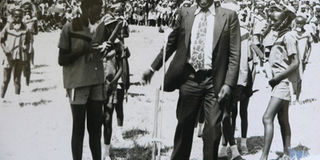Limping milk giant hopes for return of the good times

The Minister for Finance Mwai Kibaki, seen here joining children in a jig in 1977 before he went to officially open the Nyahururu KCC Milk Processing factory. After 70 years of prosperity it died – then resurrected – that is the story of the Kenya Co-operative Creameries. PHOTO|FILE.
What you need to know:
- Weighed down with colossal debts inflicted by corruption, the 85-year-old dairy farmers’ cooperative had collapsed in 1998.
- Corruption, multiplicity of committees appointed to run it, failure to pay dairy farmers, political interference, is the sad story which plagued Kenya Co-operative Creameries for a decade.
- The Government used an ambiguity in law to interfere with KCC at will, causing even more confusion in the running of the farmers’ body.
- In its 2006/7 annual report, it was posting a pre-tax profit of 65 per cent at Sh384 million.
After 70 years of prosperity it died – then resurrected – that is the story of Kenya Co-operative Creameries.
For many years, it was Kenya’s biggest milk processor but today it plays second fiddle to new entrants like Brookside.
Weighed down with colossal debts inflicted by corruption, the 85-year-old dairy farmers’ cooperative had collapsed in 1998.
While under receivership, a group of friends in Kanu during the Moi era, only known then as ‘investors’, bought it at a paltry Sh400 million.
This is compared with its huge assets spread across the country. The investors renamed it KCC 2000.
But exactly what brought down the once wealthy KCC?
Corruption, multiplicity of committees appointed to run it, failure to pay dairy farmers, political interference, is the sad story which plagued Kenya Co-operative Creameries for a decade.
It all began in earnest in 1992 with the appointment of a Board headed by a former MP, Nathaniel Chebelyon.
By 1995, the then Agriculture Minister Simeon Nyachae sounded the alarm bells.
He disclosed an officer at KCC had ordered for packaging materials worth Sh250 million, yet dairy farmers were not getting their dues.
But Nyachae’s was just a tip of the iceberg which was to come to the fore three years later.
An investyigation team appointed in 1996 unravelled everything that led to the bankruptcy of KCC.
The investigation report pointed out that the Chebelyon team had destroyed every internal management system, instead appointing consultants as a conduit for funnelling cash out of the then dairy giant.
They appointed consultants for security, insurance, finance and marketing – on whom they spent Sh30 million between 1992 and 1995.
“The consultancies were not at all necessary and where they were, KCC could have negotiated lower quotations considering its poor cash flow,” the report observed.
The directors also created an ad-hoc committee to run departments to front their personal interests.
For instance, the Tender Committee cancelled all old suppliers replacing them with the politically correct and connected to directors.
These led to exodus of qualified staff, who refused to become unprofessional and dance to directors’ tunes.
“The prices of these new companies were always three or five times more expensive than the previous prices,” the report said.
The Tender Committee turned to stock controls as their next destination.
Materials were stockpiled for up to 20 years, eating all the money that should have been paid to farmers.
For instance, detergents were bought to last for five years and packaging cartons for six years.
Packaging materials were bought for Sh220 million up from the previous Sh90 million.
Two alternative packaging systems were sourced from India at Sh12.5 million instead of Sh7.5 million the management had used previously.
“The purchasing arm was hell-bent to self-destruction,” the report said.
When Nyachae sounded the alarm, he swore that if KCC was under his agriculture docket the officer would have been sacked and made to pay.
This brought in another of persistent government interference.
The Government used an ambiguity in law to interfere with KCC at will, causing even more confusion in the running of the farmers’ body.
It had three parent ministries – Co-operatives; Agriculture; and Livestock Development.
Still, the all-powerful Office of the President at the time had its grip on KCC. For instance, when Chebelyon’s team was disbanded in 1995, the Kipkalia Kones, then Minister of State in the OP appointed a 15-member taskforce to run the dairy cooperative.
This added more confusion – there was the Board of Directors, KCC management and the taskforce clashing at all stages.
The board was even untouchable at the time as one of the directors was Raymond Moi, the son of the President.
In all these, the dairy farmers were the losers. MPs from Rift Valley where dairy farming is a major undertaking raised a storm Parliament.
The then Cherangany MP Kipruto Kirwa spearheaded it, accusing the Kanu government of political interference.
The MPs pointed out that the problem was manifested in the appointments of board members - giving the example of Raymond, as one of the politically-connected appointments.
While Rift Valley MPs fought for dairy farmers, there was apathy from their colleagues, mainly from Central who took a position that the Kanu government was simply destroying its own farmers.
The entry of Narc government under President Mwai Kibaki was something of a godsend to the farmers’ body.
In 2003, the Narc government bought back KCC for Sh547 million and handed it back to dairy farmers.
It was renamed New KCC with a new board chaired by former Mathira MP Matu Wamae.
Mr Wamae and a new Managing Director Francis Mwangi embarked on a revival plan, despite inheriting debts amounting to Sh1.2 billion.
In its 2006/7 annual report, it was posting a pre-tax profit of 65 per cent at Sh384 million.
The firm is now preparing for privatisation at the Nairobi Stock Exchange. It remains to be seen whether this will turn around its fortunes.


